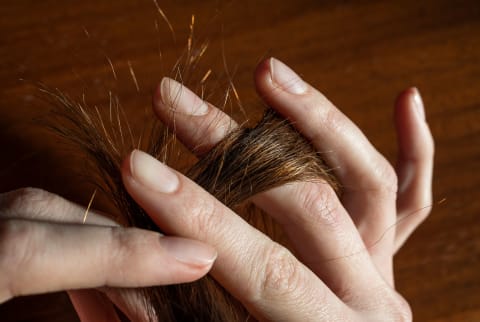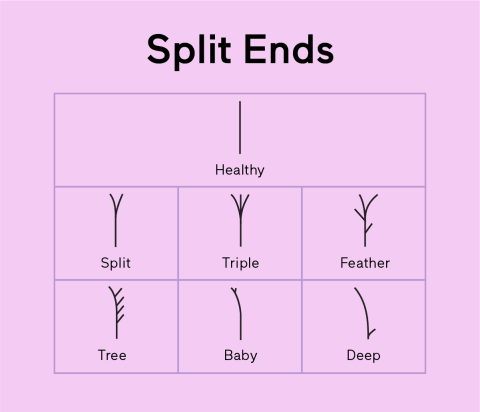Advertisement
How To Put An End To Split Ends: Causes, Tips & Products


Everyone is always talking about split ends—trim your ends, hide your splits, stop peeling your ends, etc. Clearly the beauty world wants you to know these are bad news. But why are they such a big deal? And are there other ways to get rid of these pesky splits (other than trimming them) or better yet, prevent them in the first place?
To be honest, there's so much more to know about split ends than meets the eye—here's everything you need to know about spotting them, preventing them, and hiding them for an ultra-sleek style, from experts.
What are split ends?
"Split ends are literally, exactly as they're described but often hard to see upon first glance," Andrea Hans, co-owner, executive director, and stylist at Broome Street Society in New York City, tells mbg.
If the end of your strand breaks into two, three, or even four smaller, thinner lengths, then you've got split ends. Split ends are a form of naturally occurring hair damage, meaning they're unavoidable for everyone—but can be limited with proper hair care basics.
Split end types & what it says about your hair

There's more than one kind of split end, and how each one forms actually speaks volumes about why it's splitting in the first place. Time to play detective—here are six kinds of split ends and what causes them:
Classic 2-way split
This is the most common type of split end, and they're easily formed. "They typically occur with excessive heat on the hair or overuse of chemical dyes and treatments," certified trichologist, celebrity hairstylist, and founder of scalp-first hair care brand Act + Acre Helen Reavey tells mbg.
Baby splits
Baby splits, also known as mini-splits, are a sign of a more significant split in development. "They are often caused by a lack of moisture and hydration throughout the hair stand," Reavey says. Baby splits can be harder to spot, but they're an important warning sign that your hair needs hydration quickly.
Feather splits
Feather splits have a few different splits on each side, along with a classic two-way split at the tip. "Feather splits are often due to weakened hair follicles, often from product buildup on the scalp and hair strands," Reavey says.
If you're getting feathered splits frequently, then you should take some time to evaluate your scalp health too—start here.
Triple splits
"Similar to feather splits, triple splits are often the cause of excessive dryness and overuse of heat and chemicals on already weakened strands," Reavey notes.
Both triple and feather splits are a major sign of exhaustion coming from your strands.
Tree splits
Tree splits have multiple splits on only one side of the strand.
"Tree splits typically are the result of going too long without a trim or haircut," Reavey says. "When split ends are left untouched, they are more prone to cause additional damage."
So if you have a tree split, you may be waiting a bit too long between trims—more on that in a bit.
Deep splits
Deep splits have a split end higher up on the strand, leaving the rest of the length skinny and fragile. "Similar to tree splits, deep splits are also a result of not trimming or cutting the hair," Reavey says.
So if you skip a trim, your split ends might turn into deeper splits or tree splits, but everyone's hair is unique, and your strands may even be sprinkled with both.
How to prevent split ends
Like most things in beauty, prevention is the best treatment. Let's get into how to do just that.
Reduce heat styling or use a heat protectant
As Reavey noted, split ends can come from heat damage—so keep an eye on your hot tool use. This doesn't mean you have to take a break from heat completely (unless you want to, then more power to you). But at the very least, use a heat protectant.
These topical protectant formulas coat your strands with a buffering layer of nutrients that help absorb the damage that comes from hot tools.
What's more, heat protectants often contain smoothing ingredients that will make your style look even better—here are clean options to add to your routine ASAP.
Don't sleep on wet hair if you can avoid it
If an evening rinse is your go-to, you should try to get your strands at least mostly dry before getting into bed. Wet strands are more prone to damage, and tossing and turning with your hair in an extra fragile state will only increase your chances of creating splits.
If you can't avoid sleeping on wet hair (life happens, we get it), at least try to lay your head on a satin or silk pillowcase to mitigate any unnecessary pulling or friction.
Detangle properly
Ripping through your strands aggressively, whether with a brush or your fingers, will lead to breakage. Hard stop. As stated previously, your hair is more susceptible to damage when wet, so detangle it slowly and gently.
The best route of action is to load up on a detanger (here are some DIY options) or leave-in conditioner. These coat the strands in a protective barrier, making the fiber less vulnerable to wear and tear.
"If you must detangle your hair after showering, I recommend sticking solely to a wide-toothed comb and gently detangling starting at the tips and working up to the root," Reavey says.
And if you have a knot, tread lightly. "When you come across a snag, be nice to your hair and work through it like a necklace as opposed to trying to rip through it," Hailey Nagel, stylist and educator for Innersense Organic Beauty, tells mbg.
Use sulfate-free shampoos
You'll want to keep your hair care hydrating, replenishing, and nourishing to prevent creating split ends or worsening the ones you already have.
"Sulfate and silicone-free shampoos and products work to keep the scalp microbiome balanced, giving the hair the best opportunity to strengthen and grow," Reavey notes. Always follow up with a hydrating conditioner on the lengths as well.
Be extra gentle with your strands
"Be careful not to over-scrub your ends with your hands," Hans warns. Even if you use the best products on the market, manual damage is certainly still possible.
You'll want to massage the shampoo deeply into your scalp (perhaps even add a scalp massage) and then let the water run down through the rest of your hair.
Unless you have something sticky stuck in your strands, you probably don't need to scrub the lengths at all—the runoff will get the job done just fine.
Ditch hot water
As we often recommend, avoid extremes—balance is key.
"I always remind my clients that both temperature extremes (hot and cold) can cause dehydration and constriction of nutrients to the scalp, resulting in weakness and breakage in the hair strands," Reavey says.
It's best to keep your shower water lukewarm—that goes for washing your hair and your body.
Use a microfiber hair towel
Microfiber hair towels can help mitigate frizz and damage that typical towels can produce. If you don't want to buy a specific hair towel, then an old cotton T-shirt will do.
If you do want to invest in a trusty towel, this one from Act + Acre is a top seller—and for good reason. "This towel dries hair 50% faster, all while reducing excess friction. No more frizz and damaged hair strands," Reavey says.
Get regular trims
"Split ends are most easily remedied by trimming off," Hans says. If you're in a pinch and need your hair looking pristine ASAP, then a trim is your best bet. You don't have to cut off much, but at least dusting the ends will work wonders for the look, feel, and health of your hair.
Best practice for trims is every three months for the sake of hair health. If you want to keep your cut looking aesthetically polished, then your trim schedule will depend on the length and style of your hair—you can read more about that here.
Split end causes
We went over many of the causes above, but as a recap—these hair habits can lead to split ends
- Heat styling
- Chemical processing
- Lack of moisture
- Styling
- Aggressive detangling
How to conceal split ends
Like we said, the only way to fix split ends is to trim them. However, you can conceal them for styling purposes. Here's what the experts suggest:
- Use hair oil on the ends: If your split ends are looking flashy, use a bit of hair oil on the ends and the lengths to give that faux never-been-touched-by-heat look.
- Style to mask the ends: Our favorite is an ultra-voluminous, salon-grade blowout. Yes, you can do this from home—here's how.
- Use a split-end mender: "I would suggest doing this if you're dead set on keeping length for a specific event and need a temporary split-end fix. Try Davines' Naturaltech Keratin Sealer on your ends, and blow dry it in—you'll be amazed," Hans says.
FAQ
Why do I have split ends when I don't use heat?
First thing first—using less heat will lead to fewer split ends. However, even without styling your hair with hot tools, strands may naturally split from typical wear and tear, manual damage from aggressive brushing or styling, harsh scrubbing in the shower, sleeping on wet hair, etc.
Why are split ends bad?
Split ends can be problematic because they make the ends of your hair more brittle. Especially when they begin to peel (like deep splits), more and more of your hair becomes fragile. If you trim off a split, you're taking away the chance for it to continue literally splitting your strand in half.
Does leave-in conditioner help with split ends?
Short answer, yes. Leave-in conditioners contain hydrating ingredients that will nourish dry strands (and yes, dry hair can lead to split ends). Look for formulas rich in emollients like shea and coconut butter and oils like argan, meadowfoam seed, and squalene. Our top pick: The Act + Acre Leave-In Conditioner.
Do split ends stop your hair from growing?
Your hair grows from the root, so a split end won't "stop" your hair from growing. However, if your ends continue to split and break off, you might not notice as much length gained over time. So no, they don't prevent growth, but split ends may make you ask yourself, "If my roots are showing, why doesn't my hair look longer?"
Should you peel your split ends?
Absolutely not. Peeling your split ends will only make the split deeper, which leaves even more of your strand brittle and damaged. We know it’s tempting to peel off the split, but contrary to what you may have heard it's actually going to make them worse, not better.
The takeaway
Split ends are pesky and can interrupt an ultra-sleek style—not to mention, they can prevent your hair from gaining noticeable length, which might be why they're so often talked about in the hair space. Even if you don't heat style your hair, manual damage via brushing, washing, and simple wear and tear can cause split ends.
Be sure to trim your hair every few months and nourish your ends to prevent them from breaking in half…or two…or three splits. And if you need your strands to look extra fab ASAP—a hair mask might do the trick, so here are our top picks if you're on the hunt.